Summary
The disruptions caused by Covid-19 over the last two years have been challenging and long lasting. Auckland in particular has had many lockdowns and is where the majority of Pacific learners live.
Pacific communities have faced the challenges of Covid-19 with resilience and schools have put in a range of responses to support Pacific learners through the disruption. This report shines a light on these challenges and shares successful strategies.
Whole article:
Learning in a Covid-19 World: The Impact of Covid-19 on Pacific LearnersIntroduction
The disruptions caused by Covid-19 over the last two years have been challenging and long lasting. Auckland in particular has had many lockdowns and is where the majority of Pacific learners live.
Pacific communities have faced the challenges of Covid-19 with resilience and schools have put in a range of responses to support Pacific learners through the disruption. This report shines a light on these challenges and shares successful strategies.
Covid-19 impact on education
Covid-19 has caused disruption in New Zealand for two years. During this time there were two nationwide lockdowns, several regional lockdowns, and other measures to manage the spread of the virus.
The first nationwide lockdown went from 25 March to 13 May 2020. For most of this period, schools and other educational facilities were closed. These lockdowns meant schools and educational facilities closed their doors and learning moved from the classroom to the homes of learners and their teachers. Schools faced new challenges in delivering education remotely.
Auckland had further disruptions, including:
- in 2020, an additional lockdown from 12 to 30 August
- in 2021, another lockdown from 14 to 17 February and then from 28 February to 7 March.
New Zealand went into to a second nationwide lockdown on 17 August 2021 following the spread of Delta, a more contagious variant of Covid-19. Again, schools and educational facilities were closed.
For most of New Zealand, this was a shorter lockdown and three weeks later most areas reverted to Alert Level 2, and schools returned to onsite learning. For Auckland, it was a different story with Alert Level 3 or 4 lasting for a total of 15 weeks. Schools were closed for Year 11 to 13 learners in Auckland for 70 days, and for Year 1 to 10 learners for 92 days. In comparison, the majority of New Zealand learners elsewhere experienced 21 days of school closures.
Now, in 2022, a more contagious variant of Covid-19, Omicron, has entered New Zealand. With high vaccination rates there has been a shift from the elimination strategy to managing transmission in the community. There have been continued disruptions to onsite learning for individuals, for classrooms, and for schools. Schools, learners, and their families are continuing to work together to minimise the impact of further disruptions on learning.
Impact on Pacific learners
Pacific learners have been especially impacted by Covid-19. Some outbreak clusters were located within groups with a high proportion of Pacific people. While Pacific people make up about seven percent of the New Zealand population, they have made up 14 percent[1] of all Covid‑19 cases since 16 August 2021 (as of 14 April 2022). With 68 percent of Pacific learners living in Auckland, the lockdowns there have affected Pacific learners greatly. The disruptions going forward, in 2022 and beyond, will likely continue to have negative impacts on Pacific learners.
Education system support for Pacific achievement
While many Pacific learners achieve at the highest levels, the education system in New Zealand has historically underdelivered for Pacific learners. The Government’s Action Plan for Pacific Education, 2020 - 2030[2] acknowledges the system shifts needed to achieve the vision of diverse Pacific learners and their families feeling safe, valued, and equipped to achieve their education aspirations.
Pacific learners continue to have lower achievement rates than the general population. Over the past five years Pacific learners’ NCEA Level 2 achievement rates have been on average five percentage points lower than the general population.
School leaver data[3] also shows how the inequities have had flow on effects after learners leave school. Pacific learners transition to tertiary education at a rate lower than the general population. In 2020, 49 percent of Pacific school leavers enrolled in tertiary education compared to 60 percent of the general population.
Covid-19 related disruptions have occurred within the context of these persistent inequities. Throughout 2020 and 2021, Pacific learners, their families, and their schools have worked hard to maintain continuity of learning through learning from home during higher Alert Levels and reengagement in onsite learning when possible. This report includes stories of challenge and grief, as well as determination, resilience, and success.
ERO is grateful for the time of all those who we surveyed and interviewed while conducting our research for this report. We would like to thank all the participating learners, teachers, and principals for generously sharing their experiences in dealing with the impacts of Covid-19. Your contribution enables us to shine a light on shared experiences of challenge and success, and to provide advice and support as we look ahead to an uncertain future.
About this report
This report looks at the impact of Covid-19 on Pacific learners. It is part of ERO’s series of reports on the impact of Covid-19 on English-medium and Māori-medium schools (for full list see Appendix A).
Understanding the impact on Pacific learners
To understand the impact on Pacific learners we collected a range of perspectives including:
- surveys of 612 Pacific learners in April and May 2020
- surveys of 457 Pacific learners in August and September 2020
- surveys of 316 Pacific learners in June and July 2021.
We have drawn on this data to discuss how Pacific learners were doing during the first year of Covid-19 (April 2020 to July 2021).
Following the Delta outbreak, ERO took a deeper look at the impacts on Pacific communities. ERO’s Pacific staff conducted talanoa to investigate the impact lockdowns and disruptions have had on Pacific learners and their families, and the specific educational challenges Pacific learners are facing. We gathered examples from schools who had put in place responses to support Pacific learners to engage in learning during the ongoing disruption. Overall, ERO conducted:
- talanoa with 32 leaders and teachers across 14 schools with significant Pacific rolls in November 2021
- talanoa with 41 Pacific learners across seven schools in November 2021.
To further inform the report’s recommendations and guidance strategies, in April 2022, ERO conducted an online talanoa session with seven school leaders where achievement for Pacific learners had improved over the pandemic, focusing on strategies they had found to be successful.
What this report covers
This report is divided into four parts.
- Part 1 sets out the impact of the first year of Covid-19 on Pacific learners.
- Part 2 sets out the impact of the Delta outbreak on Pacific learners.
- Part 3 highlights the school responses that helped.
- Part 4 focuses on concerns and next steps going forward.
This report covers English-medium schools and gathered perspectives from teachers, principals, and learners in Years 4 to 13.
Part 1: The impact of the first year of Covid-19 on Pacific learners
The impacts of Covid-19 have been widespread and numerous. ERO has been tracking these impacts since the first lockdown. This section sets out ways in which Pacific learners were impacted before the Delta outbreak. Like all learners, the first year of the pandemic impacted on Pacific learners’ learning, wellbeing, and engagement. Adults, families, teachers, and friends provided additional support to help learners to continue to engage in their education.
This section sets out what we know about the impact of the first year of Covid-19 (April 2020 to July 2021) on Pacific learners’:
- learning, including schoolwork, progress, and keeping up with learning
- wellbeing, including anxiety about Covid-19, feelings about the year ahead, and sense of happiness
- engagement, including enjoyment of learning and attendance
- support, including support from adults, families, teachers, and friends.
These findings are based on surveys conducted at three time points. ‘Agreement’ was identified as those who responded with either ‘Strongly Agree’ or ‘Agree’ to the questions. ‘Don’t know’ responses were removed from the totals. Percentages are rounded to the nearest whole number.
Pacific learner responses are examined alongside overall general population learner responses as a point of reference. Pacific learners are included in the general population responses.
Some questions asked in early 2020 are not identical to those in late 2020 and mid 2021 but are included together on graphs as the closest questions to address some concepts across the course of the pandemic.
Impact on learning
Like all learners, Pacific learners have faced challenges with their learning due to many Covid‑19 related disruptions.
Struggling with schoolwork
In mid‑2021, only half of Pacific learners felt they were coping with their schoolwork; this was similar to both early and late 2020 (see Figure 1).
Figure 1: Percentage of learners who agreed or strongly agreed that they were coping with their schoolwork

Only half of learners felt they were making good progress
Only about half of Pacific learners were positive that their learning progress had been good in the term they completed the survey. Pacific learners in late 2020 were six percentage points more positive than the general population and in mid-2021, they were four percentage points more positive (see Figure 2).
“I need to try and play less and work more.” - Year 8 Pacific learner
“Keep working hard and complete the learning you have to complete to succeed.” - Year 12 Pacific learner
Figure 2: Percentage of learners who agreed or strongly agreed that their learning progress had been good ‘this term’
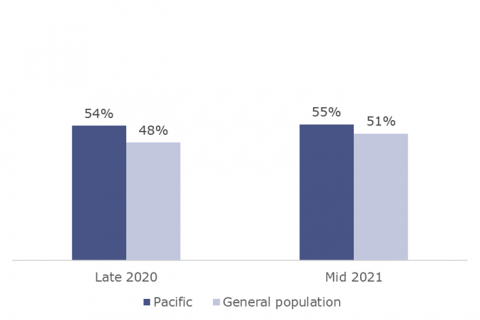
More Pacific learners felt they needed to catch up on their learning
In June and July 2021, almost half (47 percent) of Pacific learners indicated they needed to catch up on their learning. This was substantially more (15 percentage points) than the proportion of learners in the general population (32 percent) who responded the same way (see Figure 3).
“I feel that I am behind on my work and I find it a little bit hard with time management here at home. I hope to return to school real soon to catch up.” - Year 13 Pacific learner from Auckland
Figure 3: Percentage of learners who agreed or strongly agreed that they needed to catch up on their learning (mid-2021)
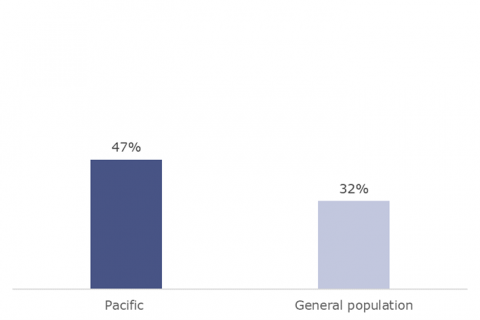
Impact on wellbeing
Covid-19 impacted on Pacific learners’ wellbeing, including anxiety about Covid-19, feeling positive about the year ahead, and their sense of happiness.
Learners remained anxious about Covid-19
In addition to anxiety about learning and feeling like they needed to catch up on their learning, Pacific learners were anxious about Covid-19. The extent to which learners have been feeling safe from Covid-19 has changed over time. In early 2020, learners were in lockdown and learning from home. At this time, most learners reported feeling safe from Covid-19, likely because their chance of exposure was limited by being at home. In late 2020, learners were feeling less safe from Covid-19, reflecting the increased risk of being out of a lockdown situation. In mid‑2021, more learners were feeling safe, reflecting the reduced risk of catching Covid-19 at a time of no recorded community transmission. Pacific learners responded in very similar ways to learners in the general population (see Figure 4).
“I don't like that we are still going to school. Because we should be at home so Covid doesn’t come to school. I really love school but still I care about our safety.” - Year 8 Pacific learner
Figure 4: Percentage of learners who agreed or strongly agreed that they were feeling safe from Covid-19
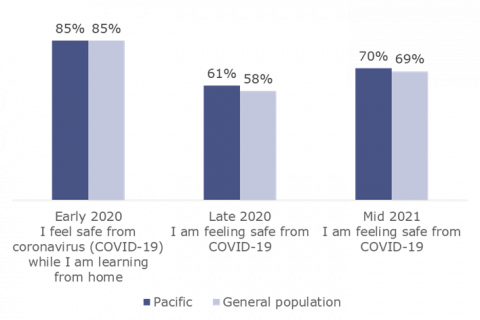
Only half of Pacific learners felt positive about the year ahead
In late 2020, we asked learners how positive they were feeling about the rest of the year and less than half of Pacific learners were feeling positive about the rest of the year. This was at a similar level (four percentage points more) to the learners in the general population (see Figure 5).
Figure 5: Percentage of learners who agreed or strongly agreed that they were feeling positive about the rest of the year (late 2020)
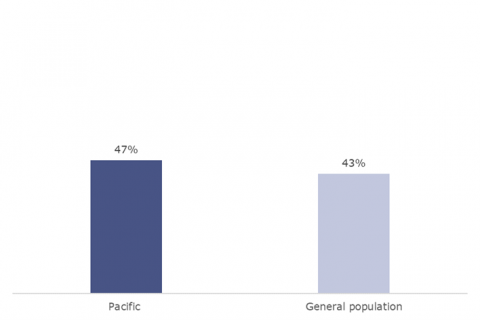
Most Pacific learners felt happy overall
Like the general population, over half of Pacific learners felt happy all of the time or most of the time in mid‑2021. More Pacific learners felt happy all of the time (six percentage points more) than learners in the general population (see Figure 6).
Figure 6: Percentages of learners who reported that they felt happy (mid-2021)
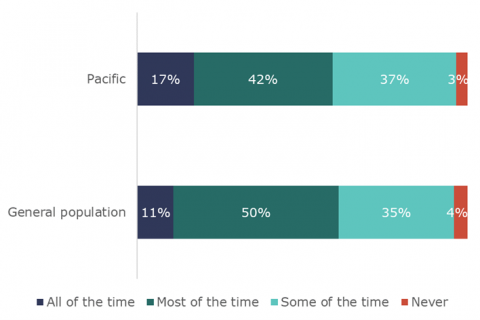
Impact on engagement with education
Engagement in education has been impacted by Covid-19, including attendance and enjoyment of learning.
Pacific learners were more positive about enjoying learning
Well over half of Pacific learners reported that they were enjoying their learning, and this had increased slightly over time. Pacific learners were enjoying their learning much more than learners in the general population across time. For example, Pacific learners were enjoying their learning 13 percentage points more in late 2020 and 18 percentage points more in mid-2021 compared to the general population. Pacific learners were also enjoying their learning at home more (seven percentage points) than the general population in early 2020 (see Figure 7).
Figure 7: Percentage of learners who agreed or strongly agreed that they were enjoying their learning
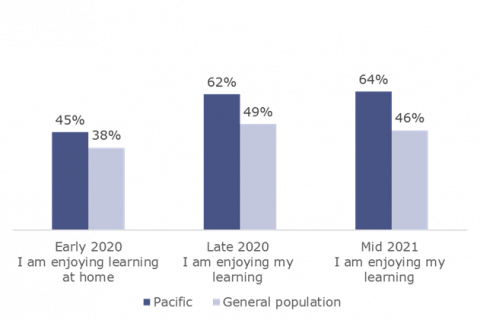
Schools were concerned about engagement
Despite many learners enjoying their learning, schools had concerns about engagement. Nearly half of the schools we talked to in late 2020 had ongoing concerns about attendance. This was more pronounced in low (deciles 1 to 3), and mid (deciles 4 to 7) decile schools compared to high decile schools (deciles 8 to 10). Pacific learners are more likely to be enrolled in lower decile schools, meaning they may be more likely to be experiencing challenges with attendance (see Figure 8).
“2020 has been the year where all hopes for productivity have relinquished. Covid-19 has stressed out everyone and held people back from reaching potential.” - Year 13 Pacific learner from Auckland
“Covid has stuffed a lot of things up. Many of us are tempted to drop out and just work.” - Year 13 Pacific learner from Auckland
Figure 8: Percentage of schools who were concerned about attendance in late 2020 by decile
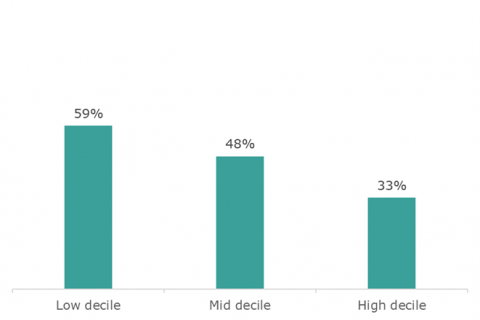
Pacific learners’ attendance was impacted
Attendance is critical for achievement, particularly at NCEA level. There is strong evidence[4] that absenteeism has negative impacts on qualification attainment.
Following the Auckland lockdown in August 2020, Pacific learners in Auckland were less likely to return to the classroom. The Ministry of Education found[5] that 22 percent of Pacific learners in Auckland did not return to school the week after lockdown, compared to only 10 percent of the general population of learners in Auckland (12 percentage points higher for Pacific learners), (see Figure 9).
Although Pacific learners were more likely to report feeling safe from Covid-19 during this period, we found that a contributing factor to attendance was health‑related anxiety, particularly for those in multi‑generational households with more vulnerable elderly family members.
“Due to Covid-19 I have not been motivated to come to school and due to that I have been missing out a lot on school.” - Year 13 Pacific learner from Auckland
Figure 9: Percentage of Auckland learners who had not returned to school the week after August 2020 Auckland lockdown
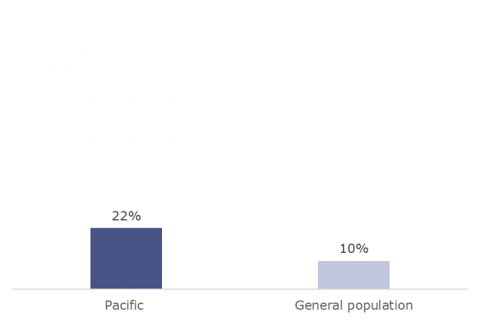
The Ministry of Education[6] also found that one month on from the Auckland lockdown in August 2020, Pacific learners in Auckland continued to show reduced attendance. The proportion of Pacific learners who were chronically absent (attending less than 70 percent of the time) that month increased 13 percentage points from 18 percent in 2019 to 31 percent in 2020 (see Figure 10).
Figure 10: Percentage of Auckland Pacific learners’ who were chronically absent in month after the 2020 Auckland lockdown compared to the same month in 2019 (pre Covid-19)

Support for Pacific learners
Schools and families provided a significant amount support to Pacific learners throughout the disruptions.
Pacific learners often had an adult they could talk to
Pacific learners, like all learners, generally felt supported by the adults in their lives. Throughout the first year of Covid-19 most learners felt there was an adult they could talk to if they were worried about something. In early 2020, this was two percentage points more for Pacific learners, in late 2020 this was seven percentage points more, and in mid-2021 this was five percentage points more than the general population (see Figure 11).
Figure 11: Percentage of learners who agreed or strongly agreed that they were feeling supported by adults
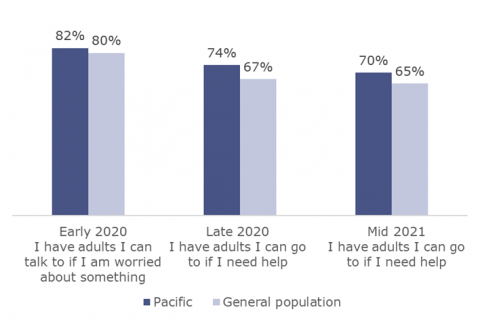
Pacific families also supported learning
Pacific learners, like learners in the general population, felt there was someone at home who could help them with their learning. This feeling was seven percentage points higher for Pacific learners in early 2020 and five percentage points higher in late 2020 (see Figure 12).
“I would like to say a huge thanks to my Mum and Dad for helping me with my schoolwork.” - Year 8 Pacific learner
“When I need help, there is a person there to help me!” - Year 6 Pacific learner
“I really focus on my assessment because my parents are supporting me with doing my assessment.” - Year 12 Pacific learner
Figure 12: Percentage of learners who agreed or strongly agreed that they had people to help with their learning at home
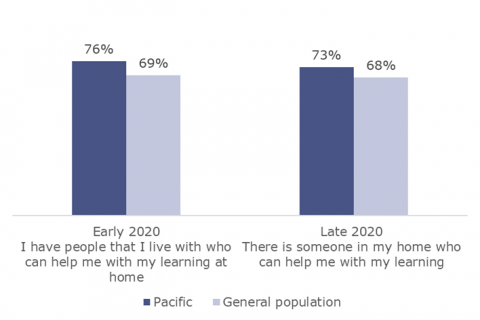
Many Pacific learners felt that there was someone at home who had become more interested in their learning in late 2020. This was higher for Pacific learners (11 percentage points more) than for learners in the general population (see Figure 13). This indicated that Pacific learners experienced a larger increase in support and interest in the term following the first national lockdown and during the term of the Auckland lockdown. ERO has previously reported[7] that schools saw greater family involvement in children’s learning as a key positive of the 2020 lockdown.
Figure 13: Percentage of learners who agreed or strongly agreed that parents or adults had become more interested in learning (late 2020)

Friends also proved a source of support to Pacific learners
Pacific learners, like most learners in the general population, have felt connected to their friends across the course of the pandemic. In early 2020, 69 percent of Pacific learners felt they had a friend they could talk to while they were learning from home. This was three percentage points less than for the general population of learners (see Figure 14).
Learners have also continued to feel connected to friends in the times following lockdowns (see Figure 15).
“l prefer learning from school with teachers and friends.” - Year 5 Pacific learner
“I would like to say that I enjoy staying in school because I get to talk to my best friends.” -Year 5 Pacific learner
Figure 14: Percentage of learners who agreed or strongly agreed that they had friends to talk to while learning form home (early 2020)

Figure 15: Percentage of learners who agreed or strongly agreed that they felt connected to their friends in the past week
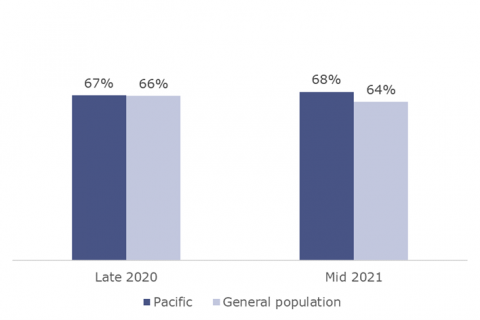
Pacific learners have felt more supported by their teachers
Pacific learners were much more likely (21 percentage points more), than learners in the general population, to say that they got extra help from their teachers when they returned to school after lockdown and that they had an adult at school who cared for them (see Figure 16 and Figure 17).
“After lockdown, I got lots of support from my teachers and during lockdown too. This really helped me get back on track with my learning.” - Year 6 Pacific learner
“The teachers are helping me with a lot of things.” - Year 6 Pacific learner
Figure 16: Percentage of learners who agreed or strongly agreed that they got extra help from their teachers (mid-2020)

Figure 17: Percentage of learners who agreed or strongly agreed that they had an adult at school who really cared about them
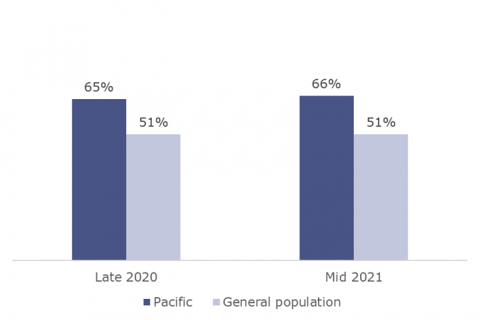
Pacific learners were between 10 and 15 percentage points more positive that their teachers cared about both their wellbeing and learning than learners in the general population (see Figures 18 and 19).
“I would like to say a big thanks to all my teachers for their care and support with my learning and wellbeing.” - Year 8 Pacific learner
Figure 18: Percentage of learners who agreed or strongly agreed that they felt their teachers cared about their learning
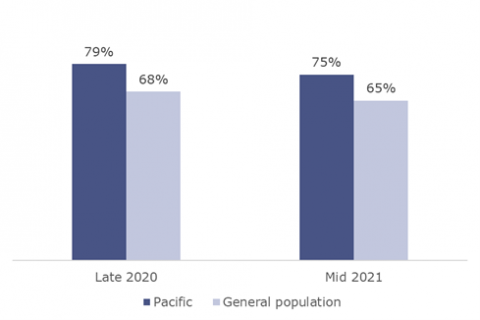
Figure 19: Percentage of learners who agreed or strongly agreed that they felt their teachers cared about their wellbeing
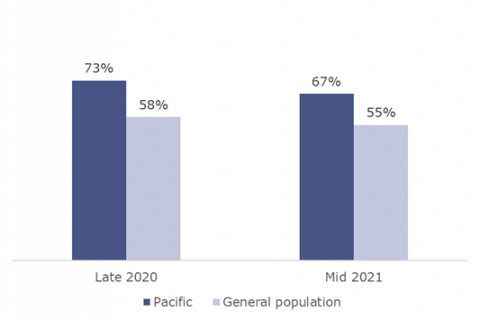
Conclusion
Prior to the Delta outbreak, only half of Pacific learners were coping with their schoolwork and felt their learning progress has been good. Pacific learners felt supported by their teachers, the adults in their lives, their families, and their friends. However, more Pacific learners felt they needed to catch up on their learning compared to learners in the general population.
Pacific learners were feeling safe from Covid-19, were feeling happy, and were still enjoying their learning but there were signs of Pacific learners disengaging from school with decreased attendance, especially following lockdown.
Part 2: The impact of the Delta outbreak on Pacific learners
The Delta outbreak in August 2021 was particularly disruptive for learners in Auckland. This outbreak and associated lockdowns and disruptions affected Auckland for significantly longer than any other part of the country. The impact of the Delta outbreak has been particularly disproportionate for Pacific learners who are highly represented in Auckland. This section sets out what we know about the impact of the Delta outbreak on Pacific learners. Delta exacerbated wellbeing and learning challenges, but Pacific learners and their families were resilient.
In the last section we saw that, prior to the Delta outbreak, the pandemic was affecting Pacific learners’ learning, wellbeing and engagement. In this section we look at the impact of the Delta outbreak, which began on 17 August 2021, on Pacific learners, including:
- wellbeing, including grief and more time to spend with families
- education challenges, including access to online learning, additional responsibilities, and language barriers
- support, including from families and communities.
Following the Delta outbreak, ERO took a deeper look at the impacts on Pacific communities. In November 2021, ERO’s Pacific staff conducted talanoa sessions with 41 Pacific learners across seven schools and with 32 leaders and teachers across 14 schools with significant Pacific rolls.
Impact on wellbeing
Dealing with grief
The 2021 Delta outbreak involved a large cluster of cases in communities with a high proportion of Pacific people. Pacific learners were more likely to be in families where members had contracted Covid‑19, been hospitalised, or died. The grief these communities experienced was compounded by the inability to have normal community gatherings and grieving rituals because of Covid-19 restrictions. Learners and their families missed out on their usual extended support systems and learners told us about the significant impact that this had.
“Funerals - attending Zoom, we had friends who lost family members and they could only attend via Zoom, imagine that, I would smash the Zoom if that was me.” – Pacific learner
More time with families
While learners and families missed the extended support of their community, the lockdown created a situation where families could spend more quality time together. We heard from Pacific learners that they valued being at home with their parents and families during higher Alert Levels because in normal times their parents would have been away working. Some Pacific families had multiple generations or extended families join their bubbles for lockdown. This provided an opportunity for great bonding with family members and, in some cases, provided learners with more people who could help with their schoolwork.
“Learners enjoyed spending time with their parents and their families because parents are usually working.” - School leader
“What [I] enjoyed the most? Spending more time with family.” – Pacific learner
Educational challenges
Less access to online learning
Access to online learning has been a recurring challenge for Pacific learners throughout the last two years of the pandemic. Both sufficiency of devices and access to reliable internet connectivity were challenges. We also heard that, even with devices and connection, some learners struggled to engage with the online tools they needed to use.
“Students with multiple siblings struggle to manage their lessons because they’re sharing.” - School leader
“Parents struggled to help their son because they have little or no knowledge of operating Zoom and Teams.” – School leaders
In June and July 2021, ERO found Pacific learners were less likely (six percentage points) than learners in the general population to report that they would be able to learn from home if there was another lockdown (see Figure 20) and less likely (eight percentage points) to have access to devices if they needed them (see Figure 21).
Figure 20: Percentage of learners who felt they would be able to learn from home if there was another lockdown (mid-2021)
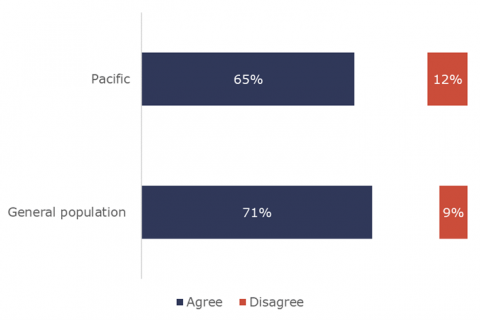
Figure 21: Percentage of learners who had a device they could use at home, if you needed to (mid-2021)
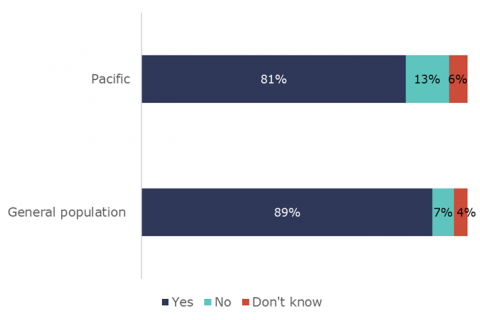
‘Don’t know’ responses have been included in this graph, as learners not knowing if they had access to a device was also important to capture
Some families faced language barriers
We heard that some Pacific families were not confident in their abilities to assist their children with remote learning. This made learning from home additionally difficult for such learners when they came across challenging concepts or content.
ERO found that communication between school and home was an important aspect of learners successfully learning from home. In situations where communication was difficult, parents and learners needed more support to make learning from home as successful as possible.
“Teachers need to understand more of our people, the language barrier for our parents…English is their second language.” – Pacific learner
Pacific learners largely preferred face-to-face learning
For many Pacific learners, online learning had not been as successful as face-to-face learning. Learning online lacked the connectedness of being in front of a teacher with their friends. We also heard that Pacific learners missed the practical approach to learning usually achieved when physically at school. They also missed the ability to get feedback as communicating with teachers wasn’t as easy outside of the classroom.
“Not being able to have the teachers to physically show me rather than online.” – Pacific learner
“It takes time for me to understand and process all the work online. More teachers to support online learning, we have one teacher to a lot of students, and we need more support with teachers.” – Pacific learner
Some Pacific learners also found the online learning style to be tiring and that it made it harder to manage their time. Limited breaks between online video classrooms were tough for some and didn’t result in optimal learning conditions. Pacific learners told us they missed having the day being broken up in the same way it is at school and having the opportunity to do physical activity such as kick a ball around with friends at lunch time.
“Back to back Zoom classrooms was difficult to manage with limited breaks. You have one class at 9am, then another class at 10 to 10—it was really hard.” – Pacific learner
There were more challenging learning environments at home for some Pacific learners
The learning environment at home was another barrier to learning effectively during lockdown that we heard about from Pacific learners. Bubble sizes varied but large bubbles often meant there was limited space for some Pacific learners to study. We also heard that there was often limited time where their house was quiet enough to focus on their schoolwork.
“Lots of people at home and it is hard to find a space to work.” – School leader
“Parents working from home and needing to use our room to work from home.” – Pacific learner
Pacific learners took on additional responsibilities
Some Pacific learners had to take on certain additional responsibilities during the lockdown as family circumstances changed. Sometimes their parents were essential workers. This often meant looking after younger siblings or doing more feau (chores) and housework with more people around.
“Having too much feau.” (chores) – Pacific learner
“Parents both essential workers – they always busy, us children we basically have to do things for ourselves.” – Pacific learner
Many Pacific learners were in families facing financial hardship because of the Delta outbreak. Some families experienced job losses due to Covid-19 and being in lockdown at home resulted in additional bills and expenses. Families also faced additional expenses such as food costs without access to school lunches for their children and with additional family members joining a household for lockdown.
“[There are] money issues for a lot of families.” – Pacific learner
As a result of this, we heard that many senior learners had taken on jobs during the Delta outbreak to support their families. This was a hard balancing act for some learners trying to continue with their studies while also providing for their families through part-time and sometimes even full-time employment. Sometimes learners had jobs with essential food services and took on more hours when available to help.
“We do a lot for our families. We are the breadwinners for our families and need to succeed at school and work.” – Pacific learner
“Most students are working part-time or helping their parents with work. Balancing work and school life was difficult for senior students.” – School leader
Support for Pacific learners through Delta
Making the best of the situation
Despite the many challenges, Pacific families and communities were active in making things work. In some cases, having more people at home helped support learners with their learning.
“My grandma motivated me to get off the phone and do my schoolwork.” - Pacific learner
Learners took initiative with their learning and created study groups to support each other. We also heard that student leadership teams went out of the way to support their community. At one school, the school leadership team created an online forum for student leaders to engage with Pacific learners to identify immediate needs for learning. The team used this information to create initiatives to address these learners’ needs.
“Prefects did some motivational work themselves which was very good and directed at the students. The service group were able to provide practical support for families.” – Leader
“Prefects sending out morning prayers (videos, written) and feedback was that they liked that – values and what is most important, feeling connected to the school.” – Teacher
“Lots of student-led activities happened over this time. Lots of interactive activities: Movie nights (Netflix group watch) Google Meets with quizzes, competitions. A whole family sent in a video all dressed in their cultural dress and sung a song.” – Pacific learner
Community support
Another positive we heard was that communities came together and supported one another. We heard stories of Pacific community groups, churches, and other local agencies helping members of the community who were struggling. This involved providing, for instance, physical care packages as well as providing a place for people to stay connected to each other and keep their spirits high. These groups were particularly effective as they were local and had a good understanding of the needs of the people they were supporting.
“The staff say one of the successes for Pacific families has been the help of outside agencies like Village connective – they engaged the students and parents and that has had a big impact on them communicating directly to their own people.” - School leader
Conclusion
Coming into the Delta outbreak, Pacific learners were reporting that the pandemic was impacting their learning. The longer time in lockdown in Auckland that came with Delta meant many Pacific learners had to deal with some of the barriers to learning for longer. Pacific learners reported having less access to devices, less space to focus and having to take on more responsibilities. Despite these challenges, Pacific learners’ families and communities rallied around them to continue to support their learning.
The interviews in this section were carried out during the Delta outbreak and provide insights that reflect the learners’ experiences at that time. It is likely that Delta and Omicron outbreaks have further exacerbated the challenges the Pacific learners raised.
Part 3: School responses that helped
In response to the educational challenges that the pandemic posed for teaching and learning, schools displayed innovation in supporting Pacific learners to reengage with learning. Schools and teachers tried to minimise the impact of the disruptions to learning continuity for their learners. Schools adapted in many ways to support Pacific learners’ engagement during and after lockdown.
The pandemic has created educational challenges and impacted on learners’ attendance and engagement. The ways in which schools have adapted their approaches and responded to support their Pacific learners are set out below. Such adaptations included:
- flexible timetables and schedules
- making culture part of learning
- understanding Pacific learners’ context
- reengaging Pacific learners in learning
- supporting the broader community.
There are links between the responses that helped and Tapasā, which is a cultural competency framework and a tool to increase the capability of teachers of Pacific learners. Three Turu (competencies) form the basis of the framework.
Turu One: Demonstrates awareness of the diverse and ethnic-specific identities, languages, and cultures of Pacific learners.
Turu Two: Establishes and maintains collaborative and respectful relationships and professional behaviours that enhance learning and wellbeing for Pacific learners.
Turu Three: Implements pedagogical approaches that are effective for Pacific learners.
The findings in this part are based on talanoa sessions with 32 leaders and teachers across 14 schools with significant Pacific rolls carried out by ERO’s Pacific staff.
Flexible timetables and schedules to support learners with jobs
“One student is working full time in a factory and she is still achieving excellence. Management of their time has been a key learning over this time.” – School leader
Schools have been supporting their Pacific learners to navigate their work and school commitments. They ensured those who had additional family responsibilities at home and work commitments could still access learning.
Below is an example of implementing Turu Three from Tapasā.
- Some schools implemented timetable flexibility. This allowed learners to manage their own schedules and complete schoolwork at a time the suited their family and work commitments. This meant learners weren’t forced to choose between continuing their study or taking on a job that conflicted with traditional school hours. Learners have been able to manage both commitments with this flexibility and support.
“Where possible, teachers discussed and negotiated amongst themselves the changes in session times in response to students’ preference.” – Teacher
“Assessment dates became flexible which supported achievement and made us think about our teaching and how we do it. We can do this even when we aren’t in lockdown – thinking of where the students are at and valuing the knowledge they already have.” –Teacher
“Evidence gathering templates and more fluid timeline for assessment. This improved engagement and accountability of students, using the template as a record of learning and it becomes a revision record as well.” – Teacher
Making culture part of learning
Schools have been supporting Pacific learners’ engagement in education by encouraging pride in their culture and heritage. During lockdown, schools celebrated cultural rituals and special occasions online to ensure the connections between home and school were maintained. We heard schools were incorporating culture as a visible and valued part of the learning programme.
Teachers implemented learning experiences that were responsive to the needs of Pacific learners and the Covid-19 context. Schools and teachers took opportunities to centre learning around learners’ own culture. Learners were allowed to use their cultural knowledge to demonstrate learning.
“What worked for our Pacific students who were disconnected during the lockdown time and reengaged willingly in Level 2 we are looking to implement across the school to further refine the culture of our school. Through valuing their own knowledge of themselves, their own family, and cultural experiences and what they have learned and bringing that into the school and the classroom.” - Leader
Schools also valued culture by setting up designated roles such as a cultural coordinator or Pacific mentors to nurture, strengthen, and support Pacific learners.
Examples of Turu One and Turu Two put in practice are listed below.
- Involvement in the various Pacific language weeks encouraged learners and their families to embrace their culture within the school context. One school normalised the use of Pacific languages through encouraging their staff to participate in Pacific language weeks and integrated Pacific words and concepts into the school vocabulary.
“I have to say that celebrating our language weeks was very successful. This was the first time for us to celebrate language week online. Surprisingly it was a huge success, families getting involved, children taking up challenges online. We celebrated Te reo Māori, Niuean, Tuvalu, Tokelau.” - Teacher
- Another school hosted mini concerts, providing an opportunity for Pacific learners to share their culture with their teachers, peers, and the rest of the school.
“We had culture events on Friday. Pacific students capitalised on this event to showcase their culture.” – Teacher
- Samoan language classes were introduced into another school’s curriculum. Samoan families were consulted in the process which strengthened relationships and trust. This change made learners feel the Samoan language was valued along with their culture and identity.
“The students and staff worked together to create face masks that represented the colours of their Pacific culture. This created a sense of connection to their cultural heritage at being able to create and wear items that represented their culture at school.” – Teacher.
- A leadership team worked alongside the community to create a cultural framework to support and guide community engagement, programme development, and teacher practice.
“[Using] programmes based on tūrangawaewae of the students. This programme became very effective in engaging students as the learning was based on the backgrounds of each. Students wanted to delve into their families’ histories and whakapapa.” – School leader
- Another school provided specific support and guidance for leaders, teachers, and teacher’s aides to engage appropriately with Pacific learners and families. Leaders and teachers were able to use this understanding to ensure that interactions were distinctive to specific Pacific identities.
“Drawing on and normalising Pasifika concepts such as the ‘Va’. Empowering staff to better support Pacific students and families. Educating non-Pacific staff about the Va and the nuanced use of it to support Pacific students.” – Leader
Knowing Pacific learners in their context
“Our curriculum changes to fit our families, we try to involve our families as much as we can, our teachers are working tirelessly in ensuring that they are connected to our students.” – School leader
We heard from Pacific learners and school leaders that schools have been making an effort to gain a greater understanding of each learner and their individual circumstances. Making these strong connections and building trust with both the learner and their family allowed teachers to better understand the context of the child and to respond more effectively to their wellbeing needs.
Some schools took additional steps to monitor each learner and their progress during this period.
Examples of Turu Two from Tapasā are included in the following points.
- Many schools provided essentials for families they knew were struggling and needed help.
“We know our families are experiencing many challenges, so we are able to provide food parcels for them. We also provide learning packs for our students and when they pick up or we drop off their learning packs we also provide bread and milk with their learning packs.” – Leader
“Healthy food helped with learning, especially in the afternoon. Less pressure on families.” – Pacific learner
“Faith is an essential component for Pasifika students. Latter Day Saints and other faith-based programmes have held programmes inside and outside of school.” – Leader
- One school had specific systems and leadership responsibilities designed to foster and maintain connections with Pacific learners and families and enhance wellbeing.
- Another school had regular online contact with Pacific families during the lockdown period, where school leaders would support learners with their specific learning needs and guide families to access resources for wellbeing.
“We started homework centres two to three years ago to engage Pacific students.” – Teacher
- Another school had eight dedicated teachers who were given time to contact all Pacific learners about their learning and general pastoral care. This continued when learners returned to learning onsite.
“There were eight dedicated teachers who had time, to contact all Pacific students regarding their learning and general pastoral care.” – School leader
- One school teaching team, in response to the needs of the learners, became fluid in the creation of their learning experiences (online and offline). This ensured that learner voice and cultural background were encompassed in their sessions.
“Students completed surveys at the end of the week based on content and then teachers would design learning based on this data. Due to this wellbeing connection and staying connected, students were able to transition back into Level 2 learning. The teachers had to work laterally and creatively to design programmes to engage students who were not as connected virtually.” – Leader
Learners have valued this increased support and interest in how they are doing. They have been appreciating what the school has done for them throughout the disruptions. As a result, they have felt closer to their teachers with an increased sense of trust.
“Students appear more grateful and appreciative of the support their teachers provided.” – School leader
Reengagement in learning
Schools have been deliberate with their reengagement strategies for moving learners back to onsite learning. They have been promoting wellbeing and focusing on reconnecting learners back into their school community.
Teachers also kept the focus on enjoyable activities rather than getting straight into learning when learners returned. Schools recognised the importance of getting learners physically back to school following lockdowns and have encouraged this through creating a fun and pressure‑free environment. Once learners felt comfortable and settled back at school, then schools began to reintroduce a stronger focus on academic achievement and assessments. Even then, school leaders were adapting assessments to ensure that the cultural perspective and wellbeing of the learner was valued.
Schools also continued to support learners who were unable to return to the classroom. Some families didn’t feel comfortable sending their children back to school due to health reasons and anxiety about Covid-19. Schools kept providing remote learning to these families so the learners could continue their learning.
Examples of this are listed below.
- Schools retained small bubbles of learners onsite to help re-establish friendships or organised school lunches to be eaten all together to build connections across the school.
- Schools focused on the wellbeing of learners and were responsive to their needs.
“Teachers aren’t going that hard right now, normally they got us straight into some work but with no fitness, skip the fitness, but now they are straight into fitness with fun activities, then back to class for work but with no internet and screen time. On Fridays we are outside for the whole time.” – Pacific learner
“[Our] school prioritised students' well-being. [We were] flexible and adaptive, not rigid regarding students' learning and assessment demands. [I] listened and responded to their wellbeing issues. [I] made allowances regarding deadlines, changed internal assessments to make less demanding example from making a film to developing podcasts.” – Teacher
- Some learners and their families also had access to school nurses to help with health anxiety they might have been facing around Covid-19 or for support with physical or mental health questions they had.
Schools supported the broader community
We also heard that schools were able to draw on resources from local businesses to ensure families had internet accessibility and other necessities. Schools were able to use these resources to establish a specific community space for Pacific learners and families to collaborate, both online and offline.
Examples of this are highlighted in the quotes below.
“Lockdown was a matter of supporting the community through their contexts. Pastoral issues with food and finances. We supported certain families by having food packs available (from local businesses) and staying connected through providing devices.” – Leader
“We have the Buddhist temple supporting our families, local church groups supporting families, we are here to serve our community.” – Teacher
“Talanoa Ako was offered to parents and families from our school and other schools. Parents and families want to be connected to the school. Students see that their parents and families are learning too. Last Talanoa Ako session had groups joining from cross-region.” – Leader
Schools and communities also worked to protect their community members by supporting the vaccine drive. Double dose vaccination rates for Pacific people has (as of February 2022) exceeded 96 percent[8]. One school partnered with Pacific health agencies to host a vaccine drive at the school, making it easier for the school community to get the vaccine. Another school had their school leaders present at vaccine drives to encourage vaccine uptake. Finally, another school used social media to get the message to their parents and families.
Conclusion
Schools rallied around their learners and found innovative ways to reengage Pacific learners in school. They put effort into understanding Pacific learners’ contexts, incorporated culture into their learning, and provided flexibility to allow them to balance their commitments. As well as focusing on reengaging Pacific learners, schools supported their Pacific communities.
Part 4: Looking forward
Pacific learners have been hit particularly hard by Covid-19 and associated disruptions to schooling. We have seen the barriers they faced and the way their families, communities, and schools have worked together to support their engagement in learning. ERO has identified some concerns about the long-lasting impact that Covid-19 disruptions may have on Pacific learners.
We have seen, in previous sections of this report, that the first years of the pandemic have impacted on Pacific learners’ learning, wellbeing, and engagement. Adults, families, teachers, and friends provided additional support to help Pacific learners to continue to learn. Delta exacerbated Pacific learners’ wellbeing and learning challenges, but Pacific learners and their families were resilient. Schools also rallied around their learners and innovated to reengage Pacific learners in learning.
Before the pandemic hit, the education system in New Zealand was not delivering for all Pacific learners. While many Pacific learners achieve at the highest levels and recent trends in NCEA achievement have been encouraging, inequities for Pacific learners remain.
There is reason for concern about potential learning gaps caused by the pandemic. The disproportionate impact of the 2021 lockdowns on Pacific learners is concerning. The issues that Pacific learners have raised such as engagement, attendance, and retention are all known to impact achievement and learning.
In particular ERO has identified five areas of concern.
a) Achievement
b) Attendance
c) Mental health and wellbeing
d) Being in schools where teachers are struggling
e) Pathways after school
Achievement
Pacific learners’ enrolment-based NCEA achievement declined in 2021
Overall, NCEA Level 2 results rose in 2020 for the general population but fell in 2021. Both the rise in 2020 and the fall in 2021 were more marked for Pacific learners than for learners in the general population (see Figure 22).
The provision of additional learning credits was more generous in 2020 than in 2021 for learners outside of Auckland, Waikato, and Northland (the most impacted regions). For a description of the ways in which these NCEA credits and other modifications were assigned, see Appendix B. The timing and duration of disruptions associated with the Delta outbreak were more significant and had a greater impact, so could have also contributed to the drop in achievement rates. We may also be seeing cumulative impacts of Covid-19 disruptions on a cohort of Pacific learners.
Figure 22: Pacific and general population NCEA Level 2 achievement 2017 to 2021
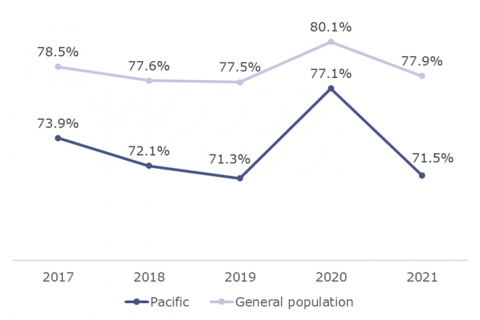
The qualification rates for different schools varied significantly. We identified 109 schools with more than 10 Pacific learners and calculated their Pacific NCEA level 2 achievement results from 2019 to 2021. Just under half of these schools saw an increase between 2019 and 2021 and just under half saw a decrease. For the remainder there was no change.
Pacific achievement rates are influenced by school decile. For NCEA Level 2, Level 3 and University Entrance (UE), Pacific learners in high decile schools were more successful (see Figure 23).
Figure 23: Overall Pacific achievement rate by decile (2021)
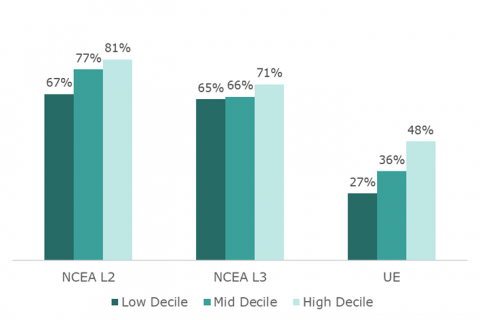
Attendance
The pandemic has affected Pacific learners’ attendance
Learners need to be in school to get the best out of their education. Research literature[9] has linked non-attendance with poorer academic achievement outcomes and also worse wellbeing and social outcomes. Evidence also suggests[10] that ‘every day counts’, indicating that every day of school attendance is an important contributor to a learner’s ability to learn and their education outcomes. There is no amount of non-attendance that won’t impact academic outcomes. Further, the effects of non-attendance are cumulative and outcomes in future years are often impacted too.
The evidence of decreased engagement and attendance of Pacific learners that we found in our surveys and interviews is backed up by attendance data[11] collected by the Ministry of Education. This data shows that attendance rates for Pacific learners following the 2021 Delta lockdown (as of 22 November 2021) were lower than for the general population (see Figure 24).
Figure 24: Average school attendance for week beginning 22 November 2021

Mental health and wellbeing
Pacific learners have been struggling with wellbeing, mental health, and anxiety throughout the pandemic
Wellbeing and good mental health are very important aspects of a successful learner. Wellbeing and positive mental health outcomes are associated with[12] concentration, motivation, and energy levels, along with the ability to cope in difficult situations and form relationships with others. These are all important prerequisites for learners to engage with learning and their ability to gain the most out of the school. There are established links[13] between children with higher levels of emotional, behavioural, social, and school wellbeing, and higher levels of academic achievement and engagement with school, both immediately and in later years.
The arrival of Covid-19 has caused health related anxiety and disruptions to learning and assessments for some learners. Transitioning in and out of lockdowns has been unsettling and the lack of certainty throughout the pandemic has been a struggle for learners.
“Covid anxiety was worse this year for [Pacific students].” – Pacific learner
“Our mental wellbeing – it can be suffocating at home, mental illness is real.” – Pacific learner
“Overwhelmed with everything and so they checked out of school because they were struggling.” -School leader
Being in schools where teachers and principals may be struggling
Pacific learners are more likely to attend schools where teachers and principals are struggling
Teachers’ and principals’ wellbeing is an important factor for learner achievement. Teacher stress and burnout can not only lead to teacher shortages but can directly impact classroom learning. Evidence[14] suggests that teachers’ wellbeing impacts on their ability to maintain relationships with their learners and manage the classroom effectively. Experiencing wellbeing challenges can lead to a lack of empathy, poorer preparation for lessons, and lower quality teaching. If teachers’ wellbeing is prioritised, it can promote a better classroom environment and success for learners.
Pacific learners are more likely to be in schools in Auckland, where we previously found[15]that teachers’ wellbeing had not recovered from the Covid-19 disruptions as much as for teachers elsewhere.
We also found that lower decile schools, where Pacific learners are more likely to be, had more difficulties filling vacancies. This added to the existing stress for principals.
Moving out of education
Some Pacific learners were having to choose between their studies and moving into full-time work to support their families
Evidence shows us[16] that remaining in education is important for improved lifelong outcomes for individuals and for society as a whole. Higher levels of education are associated with being more likely to find employment, remain employed, learn new skills, and earn more over a person’s working life. Research[17] has shown that young people who were not in employment or training in their youth experience relatively poorer outcomes two years on. They were less likely to be employed, more likely to be inactive, and/or receiving a benefit.
Some Pacific learners had family members who lost jobs or had substantially reduced income. Consequently, they needed to prioritise providing financial assistance to their family over their schooling. Data[18] suggests that this is not necessarily a widespread issue, but it is extremely significant for those learners who are facing this choice.
We heard that school leadership teams worked alongside Pacific learners and families to identify pathways to access financial support for tertiary education, through scholarships or similar initiatives.
Conclusion
Pacific learners were disproportionately impacted by the Covid-19 outbreaks in 2020 and 2021. Schools and whānau were supportive of their learning, but there are some concerns. These concerns call for a specific response to help Pacific learners to engage in their learning and achieve.
This research shows that positive practices are having a good impact in some areas and for some Pacific learners. For many Pacific learners, however, stronger and more deliberate response strategies will be required to lean against the existing inequities that have been worsened by the pandemic. This section sets out key takeaways from this report, followed by recommendations for responding to some concerns.
Pacific learners have been disproportionately impacted by Covid-19
Pacific communities and Pacific learners were disproportionately affected by the Covid-19 outbreaks in 2020 and 2021. Pacific learners also faced greater barriers to learning, with one in five Pacific learners reporting that they didn’t have or didn’t know if they had access to a device at home. They are also more likely to be in a school where teachers and the principal are struggling.
Even before the Delta and the current Omicron outbreaks, Pacific learners were more likely to report being behind in schoolwork than learners in the general population and were showing poorer attendance and a slower return to school.
The Omicron outbreak means that disruptions are expected to continue
The school responses and recommendations suggested in this report will continue to be relevant as Covid-19 continues to spread and disruptions follow. Schools, learners, and their families will need to continue to adapt to the changing circumstances and be prepared to learn remotely at times going forward. There is already evidence that Omicron is disproportionately affecting Pacific communities. Taking action to minimise the impact of these continued disruptions for Pacific learners will be essential.
Some Pacific learners are benefitting from positive practices
There has been a significant lift in Pacific families’ engagement in their children's learning. Pacific learners have reported greater support from their teachers and many schools adapted their practices to better recognise the contexts and needs of learners and their families.
Schools have worked to support the vaccine drive and are continuing to support those learners who have not been able to return to onsite schooling due to health reasons or anxiety about Covid-19. Schools have drawn on the broader community to support their teaching programmes, access to devices, and the provision of aiga/family supports.
There are some concerns in Pacific achievement that call for a targeted response
The fall in 2021 NCEA outcomes was greater for Pacific learners than for the general population.
Responding to these concerns requires deliberate action to ensure Pacific learners are not disadvantaged in the long term. This will mean prioritising reengaging Pacific learners in learning and addressing lost time. This will be important across the curriculum, but especially in the essential areas of literacy and numeracy. Schools should make every effort to identify those Pacific learners who are significantly behind and support them to identify gaps in knowledge and skills, then strengthening learners’ learning.
Recommendations
ERO recommends three areas of action.
- Building on the Action Plan for Pacific Education 2020 – 2030, education agencies need to develop a specific response to reverse the decline in achievement for Pacific learners.
This response needs to:
- focus on ensuring Pacific learners are not disadvantaged long term
- prioritise reengaging learners in schooling and address lost time in learning across the curriculum, focusing on the essential areas of literacy and numeracy, particularly for younger learners
- make every effort to identify those Pacific learners who are significantly behind and support them to identify gaps in their knowledge and skills, then strengthening their learning through:
- using teaching approaches that engage and work specifically for Pacific learners, and can be differentiated to the needs of these learners through robust planning and assessment
- noting this may be in the context of the whole school or for substantial groups of learners. Evidence supports intensive small group approaches, led by people within the same culture - for example, Pacific tertiary students
- building and sustaining some of the positive features of what has worked well over the past two years
- providing more support and guidance to teachers and principals equally
- acknowledging that delivering on these needs will take additional resources.
ERO to work specifically with those schools who are seeing declining achievement of their Pacific learners.
ERO will work with the schools where Pacific learners’ learning, progress, and achievement has declined, and learning and wellbeing outcomes indicate further support is required. ERO will support the school’s continuous improvement journey with our evaluation expertise. We will collaborate with schools to help them find ways to strategise and prioritise action to improve Pacific learner outcomes, exploring and using the good practices in this report.
All schools to recognise the disproportionate impact of Covid-19 on Pacific learners and take proactive action to offset this impact, drawing on the best practice.
To support schools to raise and maintain Pacific achievement, we held a talanoa with seven Principals and school leaders of schools who have seen an improvement in Pacific achievement during the Covid-19 disruptions to get their ideas on what works. Some of the strategies that worked for them, as well as the positive features we identified in our research, are laid out below.
Strategies
Having a school culture that celebrates Pacific culture and prioritises Pacific learners’ achievement
Schools where Pacific learners did well over the pandemic already had a culture within the school that prioritised Pacific learners’ achievement and supported Pacific learners to learn.
- They allocated the ‘Pacific Portfolio’ to a senior leader in the school, signalling the importance the school placed on Pacific learner outcomes.
- They built and maintained strong relationships with Pacific learners, their families, and their communities, prior to the pandemic. When Covid-19 occurred, these schools were able to quickly mobilise their Pacific networks to support learners. As with other schools, including those with high Māori rolls, one school we talked to was able to quickly set up working groups to support Pacific learners. The working group included Pacific learners, parents, Pacific deans, and senior leadership. It discussed what worked well to support Pacific learners’ learning during lockdown, and what strategies could be put in place to improve things going forward.
As we saw in Part Three, schools built strong ties with the Pacific community throughout the pandemic. Schools used local businesses to ensure families had internet access and other necessities. Schools also remained connected to families throughout the lockdown through designated teachers who were able to maintain connections, enhance wellbeing and support Pacific learners with their learning needs.
- They valued and honoured Pacific cultures, including in schools with small numbers of Pacific learners. Schools that were able to support their Pacific learners’ achievement throughout the disruptions promoted learners’ pride in Pacific cultures and recognised learners’ cultural knowledge as a valued and visible part of learning programmes. Schools in our research included Pacific words and concepts into the school vocabulary, introduced Pacific language classes into the curriculum, and provided support and guidance for teachers on how to engage appropriately with Pacific learners and their families. In the schools where Pacific achievement was high, the Pacific learners themselves led and owned events like school-hosted cultural performances and celebrations of language weeks.
“Student agency is often paid lip service and we are a work in progress, but this is also key. For students to lead as positive role models and connect with their peers is vital.” – School leader
Knowing your Pacific learners, and supporting their learning needs
Not all learners will let teachers, or their school know when they are struggling with their learning. The schools who have seen improvements in Pacific achievement set out to increase their understanding of their Pacific learners’ home contexts and got to know their learners so they could see if they were having difficulties.
Teachers were proactive and persistent - many learners wouldn’t speak up if things weren’t okay and wouldn’t ask for help if they needed it. Schools also used any opportunity to connect with families. During lockdown that meant the leadership team delivering devices, enabling them to check up on how learners were doing in their home environment.
In another example the team identified those learners that needed to be prioritised, allowing the school to provide the targeted support to the learners that needed it most.
Schools also noted that they needed to be mindful of how learners were feeling about their own home contexts and be adaptable. They found that allowing learners to have their cameras and microphones switched off while listening into zoom calls encouraged learners to engage in remote learning. They recognised that learners who had limited spaces at home might have felt embarrassed about showing their home context to their class.
Allowing them to retain their privacy and only respond when specifically asked meant learners felt more comfortable about participating. School leaders also noted that not all learners felt confident to ask questions in front of the whole class so they provided virtual zoom ‘office hours’ where learners could log in and ask questions in a smaller and safer space.
Wellbeing and attendance and achievement
While the schools whose Pacific learners did well over the course of the pandemic had a wellbeing first approach, they often thought about wellbeing and attendance or wellbeing and achievement.
Wellbeing and attendance
Schools found food to be a great way to enhance wellbeing and encourage attendance. Having a barbeque at the school every day provided an opportunity for learners to reconnect with each other but also provided additional motivation to turn up to school and, for those in senior secondary school, get NCEA credits.
We also heard that carving some time out at the start of the day to focus on connection worked well, before changing focus to learning. For example, using whānau groups, which was a ten-minute opportunity at the start of the day for learners to share what they had been up to and connect with each other. Another school continued to have daily assemblies to retain the feeling of togetherness.
Wellbeing and achievement
Successful initiatives to raise attainment of learners included:
- using intensive tutorials to help identify gaps in learners’ knowledge and skills, then strengthening their learning. At one senior secondary school, the tutorials provided learners with the opportunity to earn NCEA credits. These were at distinct, advertised times and encouraged both achievement and attendance
- having tuakana- teina mentor groups to encourage connections through the school and to enhance wellbeing. Academic monitors were attached to the groups, who used data to support the tuakana and the teachers of the teina to provide the right help to the learners
- Pacific Wānanga that included Pacific learners from all year levels and Pacific teachers where learners could bring academic challenges to be addressed. This mirrored a village arrangement, creating connections between older and younger learners in an environment that was focused on learning.
Learning and living
As we’ve seen in our research, some learners needed to work to support their families and others were sharing devices with other family members and couldn’t always log on when the teacher was teaching.
Schools where Pacific learners did well accepted the learners’ context and made learning work for them. They recognised the importance of not making learners feel guilty for having work or other family commitments that interfered with their schooling but focused on supporting learners to manage both.
There were two different ways schools achieved this.
- Schools provided multiple ways to engage in learning. Learners could attend class, live stream from home or having downloadable content for each subject available online. This means learners could complete their work at a time that suited them.
- Looked at how they could provide flexibility in their timetables and schedules of learning. For example, having subject days instead of covering multiple subjects in a day. Learners could then attend as much of that day as possible.
This flexibility was coupled with trust and expectations that the learners would complete the work in the given time frame. Learners were more able to manage their work and family commitments with this approach.
“They could pick and choose when in the day they’d do the work, but they had to do the work”.
However, flexibility does not work for every learner. The schools identified which learners would benefit from the stricter routines of being back in the classroom, and proactively engaged with them to get them back to school. For example, prioritising face-to-face learning just before exams to inspire an academic mindset.
Useful resources
Schools can draw on the Tapasā framework[19] to help guide their work with Pacific learners and to review and improve their practice to support Pacific learners and their families more effectively.
ERO’s report on strategies for reengaging learners in a classroom are also useful resources:
- Learning in a Covid-19 World: Supporting Primary Students as they Return to the Classroom[20]
- Learning in a Covid-19 World: Supporting Secondary School Students as they Return to the Classroom[21]
- Learning in a Covid-19 World: Supporting Secondary School Engagement [22]
Other useful resources are:
- Best practice for teaching Pacific learners: Pacific Evidence Brief 2019[23]
- Action plan for Pacific Education 2020-2030: Supporting research and community voice[24]
- Research to understand the features of quality Pacific bilingual education: Review of best practices[25]
- Language Enhancing the Achievement of Pasifika (LEAP)[26]
Appendix A
List of previous publications about Covid-19 in English-medium schools:
Covid-19 Learning in Lockdown[27]
Learning in a Covid-19 World: The Impact of Covid-19 on Schools[28]
Learning in a Covid-19 World: Supporting Primary School Students as They Return to the Classroom[29]
Learning in a Covid-19 World: Supporting Secondary School Students as They Return to the Classroom[30]
Learning in a Covid-19 World: Supporting Secondary School Engagement.[31]
Learning in a Covid-19 World: The Impact of Covid-19 on Teachers and Principals[32]
He Iho Ruruku - English medium perspectives[33]
List of previous publications about Covid-19 in Maori-medium schools:
The COVID-19 Story of Te Aho Matua Kura[34]
Te Kahu Whakahaumaru – Ngā mahi a te rangai mātauranga Māori (English)[35]
Te Muka Here Tangata – The strand that binds people[36]
He Iho Ruruku - Ngā Kura ā Iwi perspectives[37]
He Iho Ruruku - Te Aho Matua perspectives[38]
Appendix B
NCEA systems supports put in place in 2020[39]
For learners in Auckland Learning Recognition Credits (LRC) were administered as follows:
1 extra LRC for every 4 NCEA credits achieved through internal or external assessment, to a maximum of:
16 credits for learners studying for NCEA level 1
12 credits for learners studying for NCEA level 2
12 credits for learners studying for NCEA level 3
For learners outside of Auckland LRCs were administered as follows:
1 extra LRC for every 5 NCEA credits achieved through internal or external assessment, to a maximum of:
10 credits for learners studying for NCEA level 1
8 credits for learners studying for NCEA level 2
8 credits for learners studying for NCEA level 3
Changes to exam dates and portfolio due dates
Portfolio due dates and exams for NCEA and NZ Scholarship were moved later to give learners more time to learn and prepare.
Changes to University Entrance
UE requirements were reduced from 14 to 12 NCEA credits in three UE-approved subjects. Learners still needed to attain NCEA Level 3 and meet literacy and numeracy requirements to be awarded University Entrance.
NCEA systems supports put in place in 2021[40]
For learners in Auckland Learning Recognition Credits (LRC) were administered as follows:
1 extra LRC for every 4 NCEA credits achieved through internal or external assessment, to a maximum of:
16 credits for learners studying for NCEA level 1
12 credits for learners studying for NCEA level 2
12 credits for learners studying for NCEA level 3
For learners in Northland and parts of Waikato Learning Recognition Credits (LRC) were administered as follows:
1 extra LRC for every 5 NCEA credits achieved through internal or external assessment, to a maximum of:
10 credits for learners studying for NCEA level 1
8 credits for learners studying for NCEA level 2
8 credits for learners studying for NCEA level 3
For learners outside of Auckland LRCs were administered as follows:
1 extra LRC for every 5 NCEA credits achieved through internal or external assessment, to a maximum of:
8 credits for learners studying for NCEA level 1
6 credits for learners studying for NCEA level 2
6 credits for learners studying for NCEA level 3
Changes to University Entrance
For learners in Auckland, Northland and parts of Waikato UE requirements were reduced from 14 to 12 NCEA credits in three UE-approved subjects.
Learners outside of these regions needed the normal 14 credits in 3 UE-approved subjects.
Learners still needed to attain NCEA Level 3 and meet literacy and numeracy requirements to be awarded University Entrance.
References
Ministry of Health. (2022). COVID-19: Case demographics. https://www.health.govt.nz/our-work/diseases-and-conditions/covid-19-novel-coronavirus/covid-19-data-and-statistics/covid-19-case-demographics
Ministry of Education. (2021). Action Plan for Pacific Education 2020–2030. https://www.education.govt.nz/our-work/overall-strategies-and-policies/action-plan-for-pacific-education-2020-2030/
Education Counts. (2021). Education Indicator -School leaver destinations. Ministry of Education. https://www.educationcounts.govt.nz/__data/assets/pdf_file/0003/208092/Indicator-School-Leaver-destinations-2020.pdf
Webber, A. (2020). He Whakaaro: What is the relationship between attendance and attainment? Ministry of Education. https://www.educationcounts.govt.nz/publications/schooling/he-whakaaro-what-is-the-relationship-between-attendance-and-attainment
Webber, A. (2020). He Whakaaro: How COVID-19 is affecting school attendance? Ministry of Education. https://www.educationcounts.govt.nz/__data/assets/pdf_file/0014/204611/How-COVID-19-is-affecting-school-attendance-Appendix.pdf
Webber, A. (2020). He Whakaaro: How COVID-19 is affecting school attendance? Ministry of Education. https://www.educationcounts.govt.nz/__data/assets/pdf_file/0013/204610/How-COVID-19-is-affecting-school-attendance.pdf
Education Review Office. (2021). Learning in a Covid-19 World: The Impact of Covid-19 on Schools. https://ero.govt.nz/our-research/learning-in-a-covid-19-world-the-impact-of-covid-19-on-schools
Ministry of Health. (2022). COVID-19: Vaccine data. https://www.health.govt.nz/our-work/diseases-and-conditions/covid-19-novel-coronavirus/covid-19-data-and-statistics/covid-19-vaccine-data
Australian Institute for Teaching and School Leadership. (n.d.). Spotlight- Attendance Matters. https://www.aitsl.edu.au/docs/default-source/research-evidence/spotlight/attendance-matters.pdf
Hancock, K. J., Shepherd, C. C., Lawrence, D., & Zubrick, S. R. (2013). Student attendance and educational outcomes: Every day counts. Canberra: Department of Education, Employment and Workplace Relations. https://www.researchgate.net/publication/254863068_Student_Attendance_and_Educational_Outcomes_Every_Day_Counts
Education Counts. (2021). Schools On-site Attendance 22 Nov 2021 – 26 Nov 2021, COVID-19 Alert Levels 2 and 3. Ministry of Education https://www.educationcounts.govt.nz/__data/assets/pdf_file/0006/210030/2021-11-22-26-Week-Attendance-Schools-Report.pdf
Oxford Education. (2021). Could student wellbeing be linked to academic achievement?. https://educationblog.oup.com/primary/could-student-wellbeing-be-linked-to-academic-achievement
Gutman, L. M., & Vorhaus, J. (2012). The impact of pupil behaviour and wellbeing on educational outcomes. Institute of Education, University of London. https://assets.publishing.service.gov.uk/government/uploads/system/uploads/attachment_data/file/219638/DFE-RR253.pdf
Cann R. (2020). The importance of teacher wellbeing. The Education Hub. https://theeducationhub.org.nz/the-importance-of-teacher-wellbeing/
Education Review Office. (2021). Learning in a Covid-19 World: The Impact of Covid-19 on Teachers and Principals. https://ero.govt.nz/our-research/learning-in-a-covid-19-world-the-impact-of-covid-19-on-teachers-and-principals
OECD Education GPS. (2021). Economic & Social outcomes. https://gpseducation.oecd.org/revieweducationpolicies/#!node=41761&filter=all
Samoilenko, A., & Carter, K. (2015). Economic Outcomes of Youth not in Education, Employment or Training (NEET). (No. 15/01). New Zealand Treasury working paper. https://www.treasury.govt.nz/publications/wp/economic-outcomes-youth-not-education-employment-or-training-neet-html
Webber, A. (2020). He Whakaaro: Is COVID-19 making students leave school? Ministry of Education https://www.educationcounts.govt.nz/publications/series/he-whakaaro/he-whakaaro-is-covid-making-students-leave-school
Te Kete Ipurangi. (n.d.). An introduction to Tapasa. https://pasifika.tki.org.nz/Tapasa
Education Review Office. (2021). Learning in a Covid-19 World: Supporting Primary School Students as They Return to the Classroom https://ero.govt.nz/our-research/learning-in-a-covid-19-world-supporting-primary-school-students-as-they-return-to-the-classroom
Education Review Office. (2021). Learning in a Covid-19 World: Supporting Secondary School Students as They Return to the Classroom. https://ero.govt.nz/our-research/learning-in-a-covid-19-world-supporting-secondary-school-students-as-they-return-to-the-classroom
Education Review Office. (2021). Learning in a Covid-19 World: Supporting Secondary School Engagement. https://ero.govt.nz/our-research/learning-in-a-covid-19-world-supporting-secondary-school-engagement
Ministry of Education. (2020). Best practice for teaching Pacific learners: Pacific Evidence Brief 2019. https://www.educationcounts.govt.nz/publications/pasifika_education/best-practice-for-teaching-pacific-learners-pacific-evidence-brief
Pacific Education Policy team, Ministry of Education. (2020). Action plan for Pacific Education 2020-2030: Supporting research and community voice. https://www.educationcounts.govt.nz/publications/pasifika_education/action-plan-for-pacific-education-2020-2030
May, S. (2020). Research to understand the features of quality Pacific bilingual education: Review of best practices. Ministry of Education. https://www.educationcounts.govt.nz/publications/pasifika_education/research-to-understand-the-features-of-quality-pacific-bilingual-education
Te Kete Ipurangi. (n.d.). Language Enhancing the Achievement of Pasifika (LEAP). https://pasifika.tki.org.nz/LEAP
Education Review Office. (2020). Covid-19 Learning in Lockdown. https://ero.govt.nz/our-research/covid-19-learning-in-lockdown
Education Review Office. (2021). Learning in a Covid-19 World: The Impact of Covid-19 on Schools. https://ero.govt.nz/our-research/learning-in-a-covid-19-world-the-impact-of-covid-19-on-schools
Education Review Office. (2021). Learning in a Covid-19 World: The Impact of Covid-19 on Teachers and Principals. https://ero.govt.nz/our-research/learning-in-a-covid-19-world-the-impact-of-covid-19-on-teachers-and-principals
Education Review Office. (2022). He Iho Ruruku - English medium perspectives. https://ero.govt.nz/our-research/he-iho-ruruku-english-medium-perspectives
Education Review Office. (2021). The COVID-19 Story of Te Aho Matua Kura. https://ero.govt.nz/our-research/the-covid-19-story-of-te-aho-matua-kura
Education Review Office. (2021). Te Kahu Whakahaumaru – Ngā mahi a te rangai mātauranga Māori (English). https://ero.govt.nz/our-research/te-kahu-whakahaumaru-nga-mahi-a-te-rangai-matauranga-maori-english
Education Review Office. (2021). Te Muka Here Tangata – The strand that binds people. https://ero.govt.nz/our-research/te-muka-here-tangata-the-strand-that-binds-people
Education Review Office. (2022). He Iho Ruruku - Ngā Kura ā Iwi perspectives. https://ero.govt.nz/our-research/he-iho-ruruku-nga-kura-a-iwi-perspectives
Education Review Office. (2022). He Iho Ruruku - Te Aho Matua perspectives. https://ero.govt.nz/our-research/he-iho-ruruku-te-aho-matua-perspectives
New Zealand Qualifications Authority. (2020). Changes to NCEA and UE for 2020. https://www.nzqa.govt.nz/ncea/understanding-ncea/changes-to-ncea-and-ue-for-2020/
New Zealand Qualifications Authority. (2021). Changes to NCEA and UE for 2021. https://www.nzqa.govt.nz/ncea/understanding-ncea/changes-to-ncea-and-ue-for-2021/
[1] https://www.health.govt.nz/our-work/diseases-and-conditions/covid-19-novel-coronavirus/covid-19-data-and-statistics/covid-19-case-demographics
[2] https://www.education.govt.nz/our-work/overall-strategies-and-policies/action-plan-for-pacific-education-2020-2030/
[3] https://www.educationcounts.govt.nz/__data/assets/pdf_file/0003/208092/Indicator-School-Leaver-destinations-2020.pdf
[4] https://www.educationcounts.govt.nz/publications/schooling/he-whakaaro-what-is-the-relationship-between-attendance-and-attainment
[5] https://www.educationcounts.govt.nz/__data/assets/pdf_file/0014/204611/How-COVID-19-is-affecting-school-attendance-Appendix.pdf
[6] https://www.educationcounts.govt.nz/__data/assets/pdf_file/0013/204610/How-COVID-19-is-affecting-school-attendance.pdf
[7] https://ero.govt.nz/our-research/learning-in-a-covid-19-world-the-impact-of-covid-19-on-schools
[8] https://www.health.govt.nz/our-work/diseases-and-conditions/covid-19-novel-coronavirus/covid-19-data-and-statistics/covid-19-vaccine-data
[9] https://www.aitsl.edu.au/docs/default-source/research-evidence/spotlight/attendance-matters.pdf
[10] https://www.researchgate.net/publication/254863068_Student_Attendance_and_Educational_Outcomes_Every_Day_Counts
[11] https://www.educationcounts.govt.nz/__data/assets/pdf_file/0006/210030/2021-11-22-26-Week-Attendance-Schools-Report.pdf
[12] https://educationblog.oup.com/primary/could-student-wellbeing-be-linked-to-academic-achievement
[13] https://assets.publishing.service.gov.uk/government/uploads/system/uploads/attachment_data/file/219638/DFE-RR253.pdf
[14] https://theeducationhub.org.nz/the-importance-of-teacher-wellbeing/
[15] https://ero.govt.nz/our-research/learning-in-a-covid-19-world-the-impact-of-covid-19-on-teachers-and-principals
[16] https://gpseducation.oecd.org/revieweducationpolicies/#!node=41761&filter=all
[17] https://www.treasury.govt.nz/publications/wp/economic-outcomes-youth-not-education-employment-or-training-neet-html
[18] https://www.educationcounts.govt.nz/publications/series/he-whakaaro/he-whakaaro-is-covid-making-students-leave-school
[19] https://pasifika.tki.org.nz/Tapasa
[20] https://ero.govt.nz/our-research/learning-in-a-covid-19-world-supporting-primary-school-students-as-they-return-to-the-classroom
[21] https://ero.govt.nz/our-research/learning-in-a-covid-19-world-supporting-secondary-school-students-as-they-return-to-the-classroom
[22] https://ero.govt.nz/our-research/learning-in-a-covid-19-world-supporting-secondary-school-engagement
[23] https://www.educationcounts.govt.nz/publications/pasifika_education/best-practice-for-teaching-pacific-learners-pacific-evidence-brief
[24] https://www.educationcounts.govt.nz/publications/pasifika_education/action-plan-for-pacific-education-2020-2030
[25] https://www.educationcounts.govt.nz/publications/pasifika_education/research-to-understand-the-features-of-quality-pacific-bilingual-education
[26] https://pasifika.tki.org.nz/LEAP
[27] https://ero.govt.nz/our-research/covid-19-learning-in-lockdown
[28] https://ero.govt.nz/our-research/learning-in-a-covid-19-world-the-impact-of-covid-19-on-schools
[29] https://ero.govt.nz/our-research/learning-in-a-covid-19-world-supporting-primary-school-students-as-they-return-to-the-classroom
[30] https://ero.govt.nz/our-research/learning-in-a-covid-19-world-supporting-secondary-school-students-as-they-return-to-the-classroom
[31] https://ero.govt.nz/our-research/learning-in-a-covid-19-world-supporting-secondary-school-engagement
[32] https://ero.govt.nz/our-research/learning-in-a-covid-19-world-the-impact-of-covid-19-on-teachers-and-principals
[33] https://ero.govt.nz/our-research/he-iho-ruruku-english-medium-perspectives
[34] https://ero.govt.nz/our-research/the-covid-19-story-of-te-aho-matua-kura
[35] https://ero.govt.nz/our-research/te-kahu-whakahaumaru-nga-mahi-a-te-rangai-matauranga-maori-english
[36] https://ero.govt.nz/our-research/te-muka-here-tangata-the-strand-that-binds-people
[37] https://ero.govt.nz/our-research/he-iho-ruruku-nga-kura-a-iwi-perspectives
[38] https://ero.govt.nz/our-research/he-iho-ruruku-te-aho-matua-perspectives
[39] https://www.nzqa.govt.nz/ncea/understanding-ncea/changes-to-ncea-and-ue-for-2020/
[40] https://www.nzqa.govt.nz/ncea/understanding-ncea/changes-to-ncea-and-ue-for-2021/
